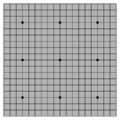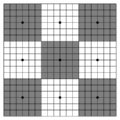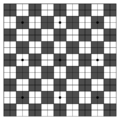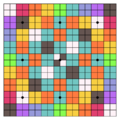Game:Kivarun Sivrak: Difference between revisions
Naitomeatori (talk | contribs) Created page with "=Kivarun Sivrak= Kivarun Sivrak is a game that is not only unplayable for mortals, but completely incomprehensible to them as well. The only mortal to have any solid understanding of the game is Valandir Raven-Kin, who was taught the game by his goddess, Ezethia. ==Basics== The game, while inaccessible to mortals, is the game that Nalieth and Kala-o play. The game board is the entire..." |
Naitomeatori (talk | contribs) No edit summary |
||
| Line 80: | Line 80: | ||
It is impossible to win the game. The game will reach a conclusion when there are no more legal moves remaining. At this point, both sides may tally their Cardinal and Secondary Stones to determine who came out ahead. However, to truly win the game, one side or the other must control every non-Star stone on the board. Since this is impossible to achieve, the game cannot be won in any capacity. The players may clear the board and begin anew, ensuring that both sides regain any stones that were captured or turned from the previous match. | It is impossible to win the game. The game will reach a conclusion when there are no more legal moves remaining. At this point, both sides may tally their Cardinal and Secondary Stones to determine who came out ahead. However, to truly win the game, one side or the other must control every non-Star stone on the board. Since this is impossible to achieve, the game cannot be won in any capacity. The players may clear the board and begin anew, ensuring that both sides regain any stones that were captured or turned from the previous match. | ||
{{ | {{DEqjc | 8#3s = 2kVXk)bq)Ghx2Ed}} | ||
}} | |||
Latest revision as of 06:59, 14 April 2025
Kivarun Sivrak
Kivarun Sivrak is a game that is not only unplayable for mortals, but completely incomprehensible to them as well. The only mortal to have any solid understanding of the game is Valandir Raven-Kin, who was taught the game by his goddess, Ezethia.
Basics
The game, while inaccessible to mortals, is the game that Nalieth and Kala-o play. The game board is the entirety of the planet Zyrkthraan and is represented by a 19x19 board similar to a Go board, and the tokens, called stones, are individual mortals that have direct connections to the realms of Celestia and Maleficence. The game ends when every stone has been "turned" to one side or the other, which is completely impossible due to the method of gameplay.
Pieces
There are many different pieces to the game that are separated into the sides of Light and Shadow. They are:
- 162 Cardinal Stones & 162 Secondary Stones
- Out of the Cardinal and Secondary Stones, there are 18 sets of stones in each that contain 9 unique colors: Red, Orange, Yellow, Green, Blue, Indigo, Purple, Ultraviolet and White. The reverse sides are the same colors, but darker shades (Maroon, Ginger, Ochre, Crusoe, Sapphire, Violet, Meteorite, Black, and Grey). The difference between the Cardinal and Secondary stones is the shape of the stones, where the Cardinal Stones are square and the Secondary Stones are round.
- 18 Controller Stones
- The Controller Stones are each a different color of the rainbow, the same as the Cardinal and Secondary Stones, with half of them being a darker shade. Unlike the Cardinal and Secondary Stones, they are partially translucent.
- 10 Permanent Captives
- The Captives do not have physical forms and are never located on the game board.
- 9 Immovable Stars
- The Stars are uniquely colored, one each of Pearl, Carmine, Poppy, Gold, Emerald, Verdigris, Glaucous, Jasmine, and Eclipse. They are rounded squares.
Board and Sectors
The board is a 19x19 grid that encompasses the current play area of Zyrkthraan. Depending on the mode of the game being used at any particular time, the board could contain many different sectors. A sector is a square space where pieces can be placed and subsequently turned or captured.
Below are some diagrams illustrating the various different sector arrangements.
-
Primary Sector
-
Secondary Sector
-
Tertiary Sector
-
Quaternary Sector
-
Quinary Sector
- The Primary Sector represents the entire planet.
- The Secondary Sectors each represent an entire quarter of the planet, such as half of the northern hemisphere.
- The Tertiary Sectors each represent a narrower area, such as an entire province.
- The Quaternary Sectors each represent an even smaller area, such as a general region.
- The Quinary Sectors each represent a specific city.
In addition, there is a color-dependent map that is overlaid over all the various sector maps, pictured below.
-
Star Map
This map is called the Star Map and denotes locations where the influence of the Star stones are greatest. Depending on the sector map, there could be one or more influencing Stars for any particular sector. However, if stones other than the traditional black and white stones are placed as the first stones in the center of the board, the Star Map is shifted accordingly in rainbow order.
One of the main goals of the game is to turn every stone in any given sector to one side, either the Light or Shadow. The gameplay switches between the different sector modes at will, with both players not being required to be making their moves on the same sector map at all times. In fact, one player may place a stone on the Tertiary Sectors, while the other player may place their next stone in the Primary Sector. By doing this, gameplay can progress across all sector maps at the same time, as higher sectors influence lower sectors.
Gameplay
The game is started by placing four initial stones in the center of the game board. It is recommended to begin with two white stones and two black stones, however any color can be used. The only requirement is that there are two colors from each side and that those colors are the same colors.
Then, the side of Shadow takes the first move. They are permitted to place one Cardinal Stone in one of the two sectors that their initial pieces were placed on or they may place a Controller into a new sector somewhere else on the board. It is illegal to place a Cardinal or Secondary Stone into a sector that does not already have a Controller within it, so if a player wishes to place stones within new sectors, they must first move a Controller into those sectors. Controllers affect all sector modes at once, so placing a Controller on a higher-level sector map will allow a player to place new Cardinal and Secondary stones in the lower-level sectors influenced by that higher-level sector.
Gameplay continues, alternating between Light and Shadow, until there are no longer any legal moves.
Capturing Stones
While the game can be played without utilizing certain functions, it is far more advantageous to do so. One of the primary elements of the game is the act of capturing stones.
Only Controllers can be captured by the opposing player. In order to capture a Controller, the other player must completely surround the sector that the Controller resides in, on the same sector map, with others of their stones (be they Cardinal or Secondary Stones, or even other Controllers). Once the sector is entirely surrounded on all sides, any opposing Controllers within that area are captured by that player.
Captured stones are removed from the board and taken into the possession of the player who captured them. In order to regain a captured stone, the other player must have a Captive to offer in return. If that player has not captured any of the other players Controllers at that point, they must trade two Permanent Captives for the single Controller. if they do have a captive Controller, though, they are required to trade it first. Only if they do not have a captured Controller may they use a Permanent Captive.
Turned Stones
Another element of the game, one that is required in order to win the game, is turning stones. While Controllers can be captured and removed from the board, Cardinal and Secondary Stones can be turned to the other side. If one was originally a stone placed by the side of Light, such as a Blue stone, and was turned to the side of Shadow, that stone would be physically turned over to reveal the Sapphire side and would then count as a Shadow stone until it was turned again by the side of Light.
Turning stones works identically to capturing Controllers, in that a player must completely surround a sector on the same sector map in order to turn them. If there is a controller in that sector, it will be captured, and all Cardinal and Secondary Stones will be turned. It is only possible to turn stones from the opposing side to the players side, as a player cannot turn their own stones to the alternate side.
Illegal Moves
While most moves are considered legal, there are those that are illegal.
- Placing a stone into a sector where it would immediately be turned or captured
- Taking two consecutive turns without allowing play by the other player
- Immediately turning a stone that was turned in the previous turn
- Immediately capturing a Controller that was placed in the previous turn
Winning the Game
It is impossible to win the game. The game will reach a conclusion when there are no more legal moves remaining. At this point, both sides may tally their Cardinal and Secondary Stones to determine who came out ahead. However, to truly win the game, one side or the other must control every non-Star stone on the board. Since this is impossible to achieve, the game cannot be won in any capacity. The players may clear the board and begin anew, ensuring that both sides regain any stones that were captured or turned from the previous match.





